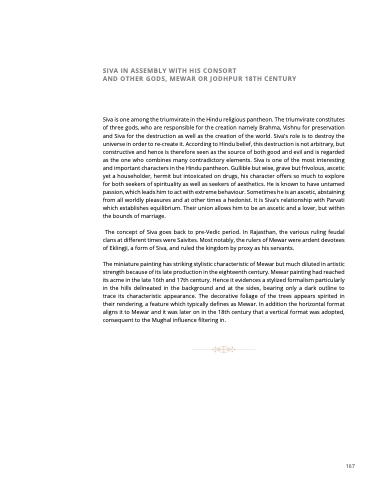Page 173 - Eye of the beholder
P. 173
SIVA IN ASSEMBLY WITH HIS CONSORT
AND OTHER GODS, MEWAR OR JODHPUR 18TH CENTURY
Siva is one among the triumvirate in the Hindu religious pantheon. The triumvirate constitutes of three gods, who are responsible for the creation namely Brahma, Vishnu for preservation and Siva for the destruction as well as the creation of the world. Siva's role is to destroy the universe in order to re-create it. According to Hindu belief, this destruction is not arbitrary, but constructive and hence is therefore seen as the source of both good and evil and is regarded as the one who combines many contradictory elements. Siva is one of the most interesting and important characters in the Hindu pantheon. Gullible but wise, grave but frivolous, ascetic yet a householder, hermit but intoxicated on drugs, his character offers so much to explore for both seekers of spirituality as well as seekers of aesthetics. He is known to have untamed passion, which leads him to act with extreme behaviour. Sometimes he is an ascetic, abstaining from all worldly pleasures and at other times a hedonist. It is Siva's relationship with Parvati which establishes equilibrium. Their union allows him to be an ascetic and a lover, but within the bounds of marriage.
The concept of Siva goes back to pre-Vedic period. In Rajasthan, the various ruling feudal clans at different times were Saivites. Most notably, the rulers of Mewar were ardent devotees of Eklingji, a form of Siva, and ruled the kingdom by proxy as his servants.
The miniature painting has striking stylistic characteristic of Mewar but much diluted in artistic strength because of its late production in the eighteenth century. Mewar painting had reached its acme in the late 16th and 17th century. Hence it evidences a stylized formalism particularly in the hills delineated in the background and at the sides, bearing only a dark outline to trace its characteristic appearance. The decorative foliage of the trees appears spirited in their rendering, a feature which typically defines as Mewar. In addition the horizontal format aligns it to Mewar and it was later on in the 18th century that a vertical format was adopted, consequent to the Mughal influence filtering in.
167


